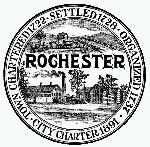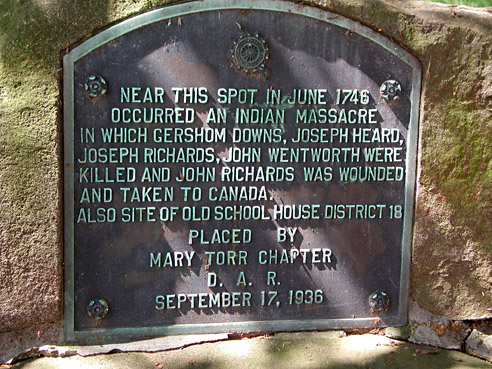

The following description of the colonial history of Rochester is posted on the website of the Rochester Historical Society. It contains the biased language that is typical of the white man's history books. "The Indian population was very sparse in this region" has become a tired cliché, one used by historians, archeologists, and anthropologists to explain away the decimation of Native populations following the invasion of Columbus. Other phrases in this piece are used to dehumanize the original inhabitants of the area: "the menace of Indians..." "[t]hey always made their victim's death a torturous experience." The description of the Penacooks' farming methods imply that they were either incompetent or negligent or simply primitive savages who knew no better.
The most offensive entry here is the final sentence: "In the 1750's the city of Rochester could concentrate on building a town instead of fending off Indians." The descendents of the people who were unable to concentrate until they'd killed all the Indians, are the people who defend their "Red Raiders" nickname as a "proud symbol of our school and our community."
 Before Rochester was settled by the White man a collection of Indian tribes known as the Pennacooks lived in and around Rochester. At their apex of power the Pennacook Indians lived in southern and central New Hampshire, southern Maine, and northeastern Massachusetts. Their population was estimated to be 12,000 and there were probably 30 villages of Pennacook Indians living in New England. Devastating epidemics of influenza, smallpox, and diphtheria wiped out many Pennacooks in the mid 1600's. These diseases were probably introduced by the European settlers. By the mid 1700's there was only one small band of Pennacook Indians left and they were living in Concord, NH.
Before Rochester was settled by the White man a collection of Indian tribes known as the Pennacooks lived in and around Rochester. At their apex of power the Pennacook Indians lived in southern and central New Hampshire, southern Maine, and northeastern Massachusetts. Their population was estimated to be 12,000 and there were probably 30 villages of Pennacook Indians living in New England. Devastating epidemics of influenza, smallpox, and diphtheria wiped out many Pennacooks in the mid 1600's. These diseases were probably introduced by the European settlers. By the mid 1700's there was only one small band of Pennacook Indians left and they were living in Concord, NH.
The Pennacook Union included the following Indian tribes;
Accominta, Agawam, Nashua, Morritigan, Naumkeag, Natticook, Newichawawock, Pennacook, Pentucket, Piscataqua, Souhegan, Squamscot, Wachusett, Wamesit, Weshacum, Winnecowet, and Winnipesaukee.
They had their own language:
PENNACOOK comes from the Indian word PENAKUK meaning "at the bottom of the hill."
The Salmon Falls River was known to the Pennacooks as NEWICHWANNOC. It was pronounced NE-GE-WON-NUCK. And this word meant 'the place of many falls.'
Gonic was known as SQUAMANAGONIC, [which] meant 'the water of the clay place hill.'
The Cocheco River is the original Pennacook Indian name. The name is broken down as follows: CO (falls) CHE (great) CO (falls), thus Cocheco means 'falls and great falls.'
The Indian population was very sparse in this region. An Indian village would have a few hundred people and the villages were far apart from each other. The Indians lived in dome-shaped cabins called wigwams. A wigwam was made by using wooden poles that were tied into a dome-shaped 'skeleton'. Animal skins and bark would be laid over the poles. They obtained their food by fishing, hunting, and farming. They grew pumpkins, squash, beans, and corn. They would plant so much that the soil would become exhausted thus forcing them to find a new spot for a village. By the 1670's all the Indians in the region were at war with the white settlers.
Because of the menace of Indians the families lived close together for personal protection. These first settlements were located near Haven Hill. To motivate the settlers of Rochester to kill Indians, a bounty was given for Indian scalps. These early settlers could earn 100 pounds for every Indian scalp that they took.
If captured by Indians the white man was either sent to Canada and held as hostage to be exchanged for a monetary payment or the Indians would kill their white captives. The Indian was not content just to kill their captive. They always made their victim's death a torturous experience. Examples of this is the treatment of "Pork" Rogers. Around Chestnut Hill Rogers was captured by Indians. The Indians tied Rogers to a tree and started a small smoky fire around him, as he was suffering from the fire the Indians would cut off pieces of flesh and throw the flesh into his face. His body was found roasting in the coals the next day.
The early history of Rochester is filled with much combat between Indians and the white settlers. Many settlers were killed or captured. It was bad enough the Pennacooks were warring with the white settlers but Mohawk Indians from French Canada would make the trip to New Hampshire to add to the killing and capturing of white settlers. The last Indian attack occurred on May 1, 1748. Jonathan Hodgon's wife was milking cows early in the morning when set upon by a party of Indians. The Indians killed her as her husband watched at a distance. By 1749 the Indians had been driven off or killed by musket or disease. In the 1750's the city of Rochester could concentrate on building a town instead of fending off Indians.

Plaque located at the top of present-day Rochester Hill.
[It's interesting that whites call the killing of four white men a "massacre" but countless incidents of white brutality since 1492—when countless Indians were killed by settlers, frontiersmen, and soldiers—were simply called "battles," if they were ever mentioned at all.]
"July 21st, John Richards and a boy of nine or ten years of age, who belonged to Rochester, in New Hampshire, were brought to prison. They told us there were four Englishmen killed when they were taken."
Nehemiah How, from his Quebec prison journal during King George's War.
(quoted in North Country Captives by Colin G. Calloway)
Rochester is a city located in Strafford County, New Hampshire, USA. As of the 2000 census, the city had a total population of 28,461, the largest in the seacoast region. The racial makeup of the city was 97.12% White, 0.52% African American, 0.22% Native American, 0.87% Asian, 0.03% Pacific Islander, 0.26% from other races, and 0.98% from two or more races. 0.90% of the population were Hispanic or Latino of any race. [Source: Wikipedia]
Red Raiders | Spaulding High School | Rochester | New Hampshire | Abenaki People | Pennacook People